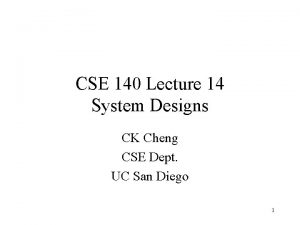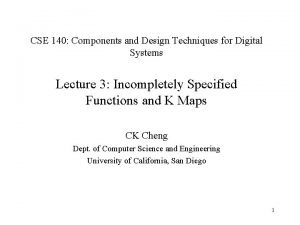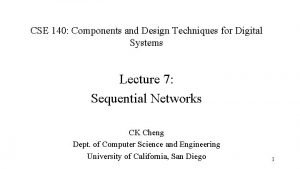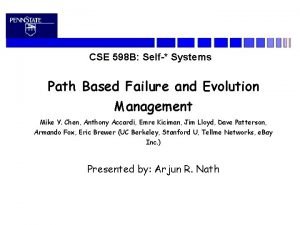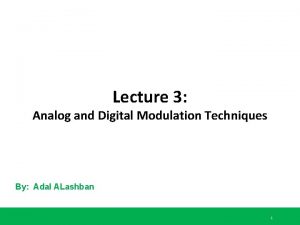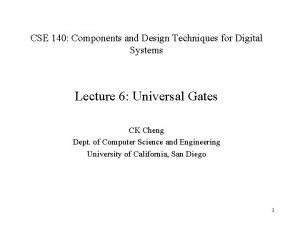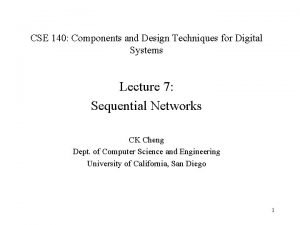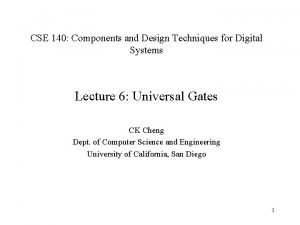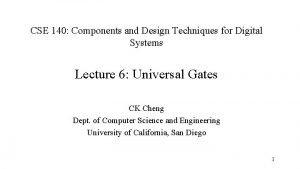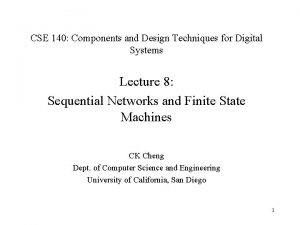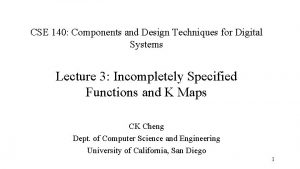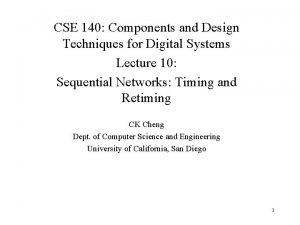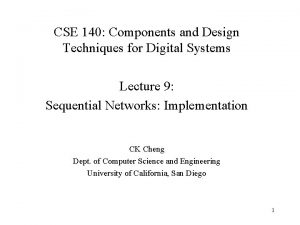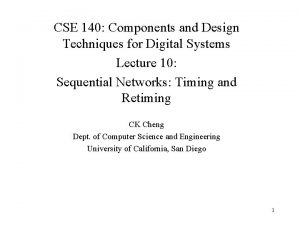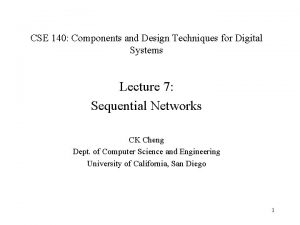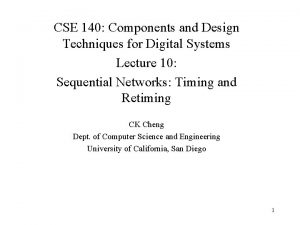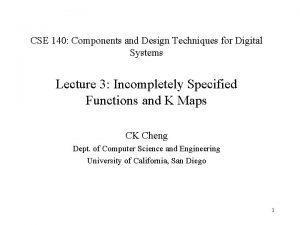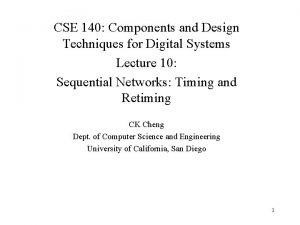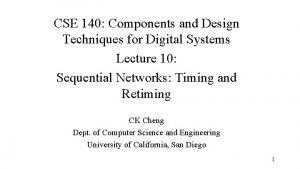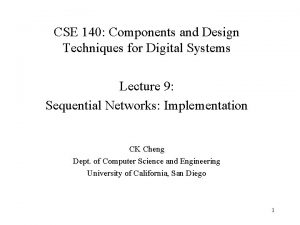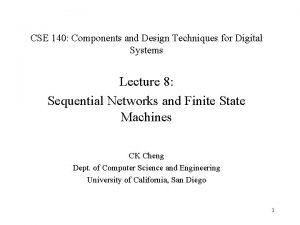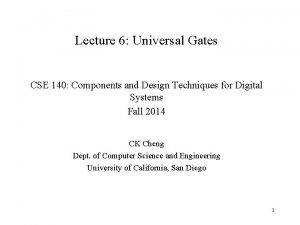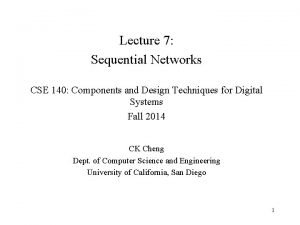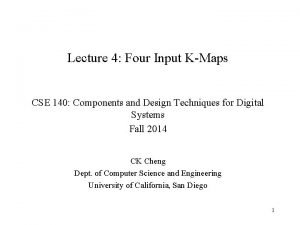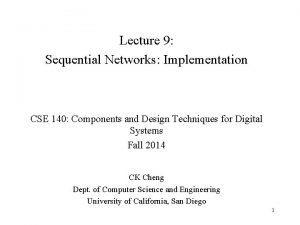CSE 140 Components and Design Techniques for Digital




















































- Slides: 52

CSE 140: Components and Design Techniques for Digital Systems Lecture 8: Sequential Networks and Finite State Machines CK Cheng Dept. of Computer Science and Engineering University of California, San Diego 1

Outlines • Specification: Finite State Machine – State Table, State Diagram, Behavior • Implementation – Excitation Table – Mealy and Moore Machines – Examples 2

Sequential Networks Y A B C D X Combinational S(t) CLK RTL: Register-Transfer Level Description 1. Components F-Fs 2. Specification 3. Implementation: Excitation Table CLK Conceptually, we can align all registers into one single column 3

Specification • Combinational Logic – Truth Table – Boolean Expression – Logic Diagram (No feedback loops) • Sequential Networks: – State Diagram, State Assignment, State Table – Excitation Table and Characteristic Expression – Logic Diagram (FFs and feedback loops) 4

FINITE STATE MACHINE OVERVIEW USING AN EXAMPLE Not all sequences are created equal: A coin has two faces. A toss of the coin lands either Head or Tail with equal probability. A series of tossing creates a sequence. Given two patterns, say HHH and HTT, the pattern appears first wins. H H H T H H A. The two patterns have an equal chance to win B. HHH wins more times C. HTT wins more times D. None of the above

NOT ALL SEQUENCES ARE CREATED EQUAL State Diagram of HHH S H/0 H H/1 H T/0 T/0 Different diagrams yield different expectations State Diagram of HTT S T/0 H H/0 T/0 H/0 T T/1 T

Implementation: Design Flow • Input Output Relation • State Diagram (Transition of states) – State minimization (Reduction) – Finite state machine partitioning • State Assignment (Map states into binary code) – Binary code, Gray encoding, One hot encoding, Coding optimization • State Table (Truth table of states) • Excitation Table (Truth table of FF inputs) – K Map, Minimal Expression – Logic Diagram 7

Implementation: Examples • Example 1: a counter from description, state diagram, state table, netlist, to I/O behavior. • Two Machines: Mealy and Moore machines • Example 2: a pattern recognizer from state diagram to netlist to demonstrate the difference of two machines. 8

Example: A Counter Behavior over time Symbol/ Circuit CLK Free running 2 bit Counter time Q 0 Q 1 What is the expected output of the counter over time? 9

Finite State Machines: Describing circuit behavior over time Symbol/ Circuit Diagram that depicts behavior over time 2 bit Counter 10

Implementing the 2 bit counter State Diagram State Table: Symbol S 0 Current state Next State S 1 S 3 State Assignment S 2 State Q 1 Q 0 S 0 0 0 S 1 0 1 S 2 1 0 S 3 1 1 S 0 S 1 S 2 S 3 S 0 Q 1(t) Q 0(t) Q 1(t+1) Q 0(t+1) State Table: Binary 11

Implementing the 2 bit counter S 0 Current state Next State S 1 S 3 S 0 S 1 S 2 S 3 S 0 S 2 State Diagram Q 1(t) Q 0(t) Q 1(t+1) Q 0(t+1) 0 0 0 1 0 1 1 1 1 0 0 State Table 12

State Table Q 1(t) Q 0(t) Q 1(t+1) Q 0(t+1) 0 0 0 1 0 1 1 1 1 0 0 D 0(t) = Q 0(t)’ D 1(t) = Q 0(t) Q 1(t)’ + Q 0(t)’ Q 1(t) Combinational circuit D Q Q’ Q 0(t) Q 1(t) CLK Circuit with 2 flip flops 13

Q 1(t) Q 0(t) Q 1(t+1) Q 0(t+1) 0 0 0 1 0 1 1 1 1 0 0 Truth table→K map→Switching function Q 0(t+1) = Q 0(t)’ Q 1(t+1) = Q 0(t) Q 1(t)’ + Q 0(t)’ Q 1(t) State Table D Q Q’ Q 0(t) Q 1(t) CLK Implementation of 2 -bit counter We store the current state using D-flip flops so that: • Inputs to the combinational circuit don’t change while the next output is being computed • The transition to the next state only occurs at the rising edge of the clock 14

Generalized Model of Sequential Circuits Y X S(t) CLK 15

Netlist State Table State Diagram Input Output Relation PSInput S 0 S 1 S 2 X=0 S 0, 0 S 3, 0 S 2, 0 S 3 S 1, 1 S 0, 1 1/1 X=1 S 2, 0 S 3, 0 S 1, 0 0/0 S 1 1/0 1 1 S 3 0, 1/0 S 2 Example: Output sequence Time 0 Input 0 State S 0 Output 0/1 0/0 2 1 3 0 4 1 5 - 16

Netlist State Table State Diagram Input Output Relation PSInput S 0 S 1 S 2 X=0 S 0, 0 S 3, 0 S 2, 0 S 3 S 1, 1 S 0, 1 1/1 X=1 S 2, 0 S 3, 0 S 1, 0 0/0 S 1 1/0 0 0 S 0 0 1 1 S 0 0 S 3 0, 1/0 S 2 Example: Output sequence Time Input State Output 0/1 0/0 2 1 S 2 0 3 0 S 1 0 4 1 S 3 1 5 S 0 0 17

Implementation State Diagram => State Table => Logic Diagram • Canonical Form: Mealy and Moore Machines • Mealy machines: General • Moore machines: Output is independent of current input. • Excitation Table • Truth Table of the F-F Inputs • Boolean algebra, K-maps for combinational logic • Examples • Timing 18

Canonical Form: Mealy and Moore Machines x(t) y(t) Combinational Logic CLK x(t) y(t) C 2 x(t) C 1 y(t) C 2 C 1 CLK 19

Canonical Form: Mealy and Moore Machines Mealy Machine: yi(t) = fi(X(t), S(t)) Moore Machine: yi(t) = fi(S(t)) si(t+1) = gi(X(t), S(t)) x(t) C 1 C 2 CLK S(t) Mealy Machine y(t) C 1 y(t) C 2 CLK S(t) Moore Machine 20

Canonical Form: Mealy and Moore Machines Mealy Machine: yi(t) = fi(X(t), S(t)) Moore Machine: yi(t) = fi(S(t)) si(t+1) = gi(X(t), S(t)) Moore Machine Mealy Machine x(t) C 1 y(t) C 2 CLK S(t) CLK Input PS Si S NS, output input/output y(t) Sj PS NS Si S output input Output Sj output 21

Example: Life on Mars? Mars rover has a binary input x. When it receives the input sequence x(t-2, t) = 001 from its life detection sensors, it means that the it has detected life on Mars and the output y(t) = 1, otherwise y(t) = 0 (no life on Mars ). Implement the Life-on-Mars Pattern Recognizer! 22

Mars Life Recognizer FSM Which of the following diagrams is a correct Mealy solution for the 001 pattern recognizer on the Mars rover? 1/1 A. 1/0 S 0 0/0 S 1 S 2 1/0 0/0 B. 1/0 S 0 0/0 C. Both A and B are correct D. None of the above S 1 1/1 0/0 Input/output S 2 1/0 23

Mars Life Recognizer FFs Mealy Machine Pattern Recognizer ‘ 001’ 1/0 x(t) 1/1 S 0 0/0 1/0 S 1 C 1 0/0 y(t) C 2 S 2 0/0 CLK S(t) What does state table need to show to design controls of C 1? A. next state S(t+1) vs. input x(t), and present state S(t) B. output y(t) vs. input x(t), and present state S(t) C. output y(t) vs. present state S(t) D. None of the above 24

State Diagram => State Table with State Assignment x(t) 1/1 1/0 0/0 S 1 0/0 C 1 S 2 0/0 1/0 C 2 CLK y(t) S(t) Mealy Machine S(t)x 0 1 S 0 S 1, 0 S 0, 0 S 1 S 2, 0 S 0, 0 S 2, 0 S 0, 1 State Assignment S 0: 00 S 1: 01 S 2: 10 S(t)x 0 1 00 01, 0 00, 0 01 10, 0 00, 0 10 10, 0 00, 1 Q 1(t+1)Q 0(t+1), y 25

State Diagram => State Table => Excitation Table => Circuit Q 1(t) Q 0(t)x 0 1 id Q 1 Q 0 x D 1 00 01, 0 00, 0 0 000 0 1 0 01 10, 0 00, 0 10 10, 0 00, 1 1 001 0 0 0 2 010 1 0 0 3 011 0 0 0 4 100 1 0 0 5 101 0 0 1 6 110 7 111 x(t) C 1 C 2 CLK S(t) Mealy Machine y(t) D 0 y 26

State Diagram => State Table => Excitation Table => Circuit id Q 1 Q 0 x D 1 D 0 y Q 1(t) Q 0(t)x 0 1 00 01, 0 00, 0 01 10, 0 00, 0 10 10, 0 00, 1 x(t) C 1 C 2 CLK S(t) Mealy Machine y(t) 0 000 0 1 001 0 0 0 2 010 1 0 0 3 011 0 0 0 4 100 1 0 0 5 101 0 0 1 6 110 7 111 i. Clicker: What to fill in rows 6 and 7 of excitation table? A. All 0 s B. All 1 s C. All Don’t Cares 27

State Diagram => State Table => Excitation Table => Circuit id Q 1 Q 0 x 0 000 D 1 0 D 0 1 Q 0 y D 1(t): 0 0 1 001 0 0 0 2 010 1 0 0 3 011 0 0 0 4 100 1 0 0 5 101 0 0 1 6 110 X X X 7 111 X X X 1 x(t) 0 0 2 3 1 0 6 7 4 X 5 X 1 0 Q 1 D 1(t) = x’Q 0 + x’Q 1 D 0 (t)= Q’ 1 Q’ 0 x’ y= Q 1 x 28

State Diagram => State Table => Excitation Table => Circuit Q’ 1 Q’ 0 x’ x’ Q 0 Q 1 D 0 D D 1 D Q Q’ Q 0 Q 1 y Q Q’ x x(t) D 1(t) = x’Q 0 + x’Q 1 D 0 (t)= Q’ 1 Q’ 0 x’ y= Q 1 x C 1 C 2 CLK y(t) S(t) Mealy Machine 29

Moore FSM for the Mars Life Recognizer Which of the following diagrams is a correct Moore solution to the ‘ 001’ pattern recognizer? input/output 1/1 A. 1/0 0/0 S 1 S 2 0/0 1/0 B. 1 0 1 S 0 0 0 1 S 1 0 output 0 input 1 S 2 0 S 3 1 0 C. Both A and B are correct D. None of the above 30

Moore Mars Life Recognizer: FF Input Specs Pattern Recognizer ‘ 001’ x(t) 1 1 S 0 0 0 S 1 0 0 1 S 2 0 0 S 3 1 C 1 S(t) C 2 y(t) CLK Moore Machine What does state table need to show to design controls of C 2? A. (current input x(t), current state S(t) vs. next state, S(t+1)) B. (current input, current state vs. current output y(t)) C. (current state vs. current output y(t) and next state) D. (current state vs. current output y(t) ) E. None of the above 31

Moore Mars Life Recognizer: State Table 1 1 0 S 0 0 1 0 0 S 1 0 1 S 2 0 S 3 1 0 ID Q 1 Q 0 x D 1 D 0 y 0 000 0 1 0 S(t)x 0 1 S 0 S 1, 0 S 0, 0 S 1 S 2, 0 S 0, 0 1 001 0 0 0 S 2, 0 S 3, 0 2 010 1 0 0 S 3 S 1, 1 S 0, 1 3 011 0 0 0 Q 1 Q 0x 0 1 4 100 1 0 0 00 01, 0 00, 0 01 10, 0 00, 0 5 101 1 1 0 10 10, 0 11, 0 6 110 0 1 1 11 01, 1 00, 1 7 111 0 0 1 Q 1(t+1)Q 0(t+1), y

Mars Life Recognizer: Circuit Design Q 0 D 1(t): 0 0 1 id Q 1 Q 0 x D 1 0 0 1 000 001 0 D 0 1 0 y 0 x(t) 2 3 2 010 1 0 0 3 011 0 0 0 4 100 1 0 0 5 101 1 1 0 6 110 0 1 1 7 111 0 0 1 0 7 0 0 4 1 5 1 Q 1 0 0 6 1 Q 0 D 0(t): 0 1 1 0 x(t) 2 0 3 0 6 1 7 0 4 0 5 1 Q 0 y(t): 0 1 x(t) 0 0 2 3 0 0 6 7 1 1 4 5 Q 1 0 0

Mars Life Recognizer Circuit Implementation State Diagram => State Table => Excitation Table => Circuit D 0 D D 1 x(t) D 1(t)= Q 1(t)Q 0(t)’+Q 1(t)’Q 0(t) x(t) D 0(t)= Q 1(t)’Q 0(t)’x(t)’+ Q 1(t)Q 0(t) x(t)’+Q 1(t)Q 0(t)’ x(t) y(t)= Q 1(t)Q 0(t) D Q 0 Q Q’ y Q 1 Q Q’ C 1 C 2 y(t) CLK S(t) Moore Machine 34

Conversion from Mealy to Moore Machine 1/1 1 1 1/0 S 0 0/0 S 1 S 2 S 0 0 0/ 0 0 1 S 1 0 0 1 S 2 0 0 0 1/0 S(t)x 0 1 S 0 S 1, 0 S 0, 0 S 1 S 2, 0 S 0, 0 S 2, 0 S 0, 1 S 2, 0 S 3 S 1, 1 S 0, 1 S 3 1

Conversion from Mealy to Moore Machine S(t)x 0 1 y S 0 S 1, 0 S 0 S 1 S 0 0 S 1 S 2, 0 S 0, 0 S 1 S 2 S 0 0 S 2, 0 S 0, 1 S 2 S 3 0 S 3 Algorithm 1. Identify distinct (NS, y) pair 2. Replace each distinct (NS, y) pair with distinct new states 3. Insert rows of present state = new states

Conversion from Mealy to Moore Machine Mealy S(t)x 0 1 y S 0 S 1, 0 S 0 S 1 S 0 0 S 1 S 2, 0 S 0, 0 S 1 S 2 S 0 0 S 2, 0 S 0, 1 S 2 S 3 0 Moore S 3 1. Find distinct NS, y 2. Add new states to represent distinct NS, y i. Clicker For the above Moore machine, what are the next states with respect to present state S 3? A. S 2, S 3, 1 B. S 2, S 0, 1 C. S 1, S 0, 1 D. S 1, S 0. 0 E. None of the above.

Conversion from Mealy to Moore Machine 1/1 0/0 1/0 S 0 1 1 0/0 S 1 0 S 0 0 S 2 0/ 0 1/0 S 1 0 S 2 0 0 0 S(t)x 0 1 S 0 S 1, 0 S 0, 0 S 1 S 2, 0 S 0, 0 S 2, 0 S 3, 0 S 2, 0 S 0, 1 S 3 S 1, 1 S 0, 1 Time 0 1 2 3 4 5 6 7 8 x 1 0 0 1 S 1 S 0 S 1 S 2 0 Smealy S 0 ymealy Smoore S 0 ymoore 1 S 3 1

Conversion from Mealy to Moore Machine 1/1 1/0 0/0 S 1 1 1 S 2 1/0 S(t)x 0 1 S 0 S 1, 0 S 0, 0 S 1 S 2, 0 S 0, 0 S 2, 0 S 0, 1 S 0 0 0/ 0 1 S 0 S 1, 0 S 0, 0 S 1 S 2, 0 S 0, 0 S 2, 0 S 3 S 1, 1 S 0, 1 2 3 4 5 6 7 8 x 1 0 0 1 S 0 S 1 S 2 ymealy Smoore S 0 ymoore 1 S 2 0 0 0 1 Smealy S 0 S 1 0 S(t)x Time 0 0 1 S 3 1 0 i. Clicker Smoore[0 -5] A. S 0, S 1, S 2, S 3 B. S 0, S 1, S 2, S 0 C. S 3, S 1, S 0, S 1, S 2, S 3 D. S 3, S 1, S 0, S 1, S 2, S 0 E. None of the above

Conversion from Mealy to Moore Machine 1/1 1/0 0/0 S 1 1 1 S 2 1/0 S(t)x 0 1 S 0 S 1, 0 S 0, 0 S 1 S 2, 0 S 0, 0 S 2, 0 S 0, 1 S 0 0 0/ 0 0 S 1, 0 S 0, 0 S 1 S 2, 0 S 0, 0 S 2, 0 S 3 S 1, 1 S 0, 1 i. Clicker ymoore[0 -5] A. 0, 0, 1, 0 B. 0, 0, 0, 1 C. 0, 1, 0, 0 D. 0, 0, 0, E. None of the above 4 5 6 7 8 x 1 0 0 1 S 0 S 1 S 2 ymoore S 3 1 S 0 3 Smoore S 0 1 1 2 ymealy 1 S 2 0 0 0 1 Smealy S 0 S 1 0 S(t)x Time 0 0

Conversion from Mealy to Moore Machine Algorithm 1. Identify distinct (NS, y) pair 2. Replace each distinct (NS, y) pair with distinct new states 3. Insert rows of present state = new states 4. Append each present state with its output y

Finite State Machine Example • Traffic light controller – Traffic sensors: TA, TB (TRUE when there’s traffic) – Lights: LA, LB 42

FSM Black Box • Inputs: CLK, Reset, TA, TB • Outputs: LA, LB 43

FSM State Transition Diagram • Moore FSM: outputs labeled in each state • States: Circles • Transitions: Arcs 44

FSM State Transition Diagram • Moore FSM: outputs labeled in each state • States: Circles • Transitions: Arcs 45

FSM State Transition Table PS S 0 S 1 S 2 S 3 Inputs TA 0 1 X X NS TB X X X 0 1 X S 1 S 0 S 2 S 3 S 2 S 0 46

State Transition Table PS Q 1(t) Q 0(t) 0 0 0 1 1 Inputs TA TB 0 X 1 X X NS Q 1(t +1) Q 0(t +1) 0 1 0 1 1 1 0 0 0 State Encoding S 0 00 S 1 01 S 2 10 S 3 11 Q 1(t+1)= Q 1(t) Q 0(t+1)= Q’ 1(t)Q’ 0(t)T’A + Q 1(t)Q’ 0(t)T’B 47

FSM Output Table PS Q 1 0 0 1 1 Q 0 0 1 LA 1 0 0 1 1 Outputs LA 0 LB 1 LB 0 0 1 1 0 0 0 1 Output Encoding green 00 yellow 01 red 10 LA 1 = Q 1 LA 0 = Q’ 1 Q 0 LB 1 = Q’ 1 LB 0 = Q 1 Q 0 48

FSM Schematic: State Register 49

Logic Diagram 50

FSM Schematic: Output Logic 51

Summary: Implementation • Set up canonical form • Mealy or Moore machine • Identify the next states • state diagram ⇨ state table • state assignment • Derive excitation table • Inputs of flip flops • Design the combinational logic • don’t care set utilization 52
 Cse 140
Cse 140 Encoder definition
Encoder definition Cse 140
Cse 140 Ff t
Ff t Svenskt ramverk för digital samverkan
Svenskt ramverk för digital samverkan Cse 598 advanced software analysis and design
Cse 598 advanced software analysis and design Digital to analog modulation techniques
Digital to analog modulation techniques Fonctions techniques et solutions techniques
Fonctions techniques et solutions techniques Digital market and digital goods
Digital market and digital goods Fspos
Fspos Typiska drag för en novell
Typiska drag för en novell Nationell inriktning för artificiell intelligens
Nationell inriktning för artificiell intelligens Vad står k.r.å.k.a.n för
Vad står k.r.å.k.a.n för Varför kallas perioden 1918-1939 för mellankrigstiden?
Varför kallas perioden 1918-1939 för mellankrigstiden? En lathund för arbete med kontinuitetshantering
En lathund för arbete med kontinuitetshantering Kassaregister ideell förening
Kassaregister ideell förening Tidbok
Tidbok A gastrica
A gastrica Densitet vatten
Densitet vatten Datorkunskap för nybörjare
Datorkunskap för nybörjare Stig kerman
Stig kerman Debattartikel mall
Debattartikel mall Magnetsjukhus
Magnetsjukhus Nyckelkompetenser för livslångt lärande
Nyckelkompetenser för livslångt lärande Påbyggnader för flakfordon
Påbyggnader för flakfordon Vätsketryck formel
Vätsketryck formel Bo bergman jag fryser om dina händer
Bo bergman jag fryser om dina händer Presentera för publik crossboss
Presentera för publik crossboss Jiddisch
Jiddisch Bat mitza
Bat mitza Klassificeringsstruktur för kommunala verksamheter
Klassificeringsstruktur för kommunala verksamheter Epiteltyper
Epiteltyper Bästa kameran för astrofoto
Bästa kameran för astrofoto Centrum för kunskap och säkerhet
Centrum för kunskap och säkerhet Lågenergihus nyproduktion
Lågenergihus nyproduktion Mat för idrottare
Mat för idrottare Verktyg för automatisering av utbetalningar
Verktyg för automatisering av utbetalningar Rutin för avvikelsehantering
Rutin för avvikelsehantering Smärtskolan kunskap för livet
Smärtskolan kunskap för livet Ministerstyre för och nackdelar
Ministerstyre för och nackdelar Tack för att ni har lyssnat
Tack för att ni har lyssnat Referatmarkeringar
Referatmarkeringar Redogör för vad psykologi är
Redogör för vad psykologi är Borstål, egenskaper
Borstål, egenskaper Atmosfr
Atmosfr Borra hål för knoppar
Borra hål för knoppar Orubbliga rättigheter
Orubbliga rättigheter Formel standardavvikelse
Formel standardavvikelse Tack för att ni har lyssnat
Tack för att ni har lyssnat Rita perspektiv
Rita perspektiv Ledningssystem för verksamhetsinformation
Ledningssystem för verksamhetsinformation Tobinskatten för och nackdelar
Tobinskatten för och nackdelar Toppslätskivling effekt
Toppslätskivling effekt
